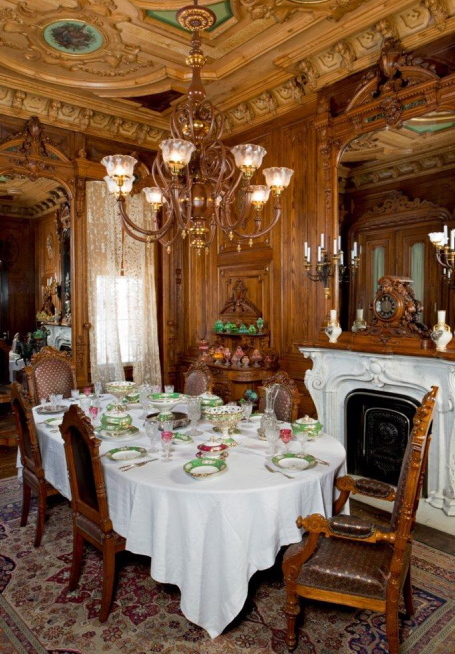Five artists were invited to create works to be displayed in Victoria Mansion – the most opulent, accurate, and beautifully presented historical domestic interior in Maine. But not all have come to celebrate the summer retreat built for Ruggles Morse between 1858 and 1860. “Mansion as Muse” splits evenly between respectful fascination and disapproval.
It might seem a bit rude to go into someone’s house and present works that, in the words of collaborators Mark Dion and Dana Sherwood, “embody decay, ruination, and entrapment.” Justin Richel takes a similar tack with his “satirically sadistic portrayals of venerated personas, defiled and worked over by the cruel caress of time.” There is plenty of literary precedent for decrying the decrepitude of opulence, including the work of Charles Dickens and Edgar Allan Poe. But the real inspiration for these three artists is Fred Wilson, whose seminal 1993 exhibition “Mining the Museum” at the Maryland Historical Society presented iron slave shackles along with fine silver as “Metalwork.”
If you have merely driven by the brownstone mansion on Danforth Street, then you haven’t seen it. The mansion has a handsome exterior, designed by Henry Austin, but it’s nothing compared to the interior design by Gustave Herter. It is a masterpiece – and Herter’s sole remaining commission.
Austin’s design appears directly inspired by Queen Victoria’s Italian villa-style Osborne House on the Isle of Wight and meanders through continental styles, including a Turkish smoking room. Consider, however, that Victoria Mansion is an extraordinary bit of antebellum culture. It may seem out of place in Portland, but while Morse humbly hailed from Maine, he made his fortune as an upper-echelon hotelier in New Orleans. Victoria Mansion expressed the extraordinary architectural sensibility, professional eye and stylish taste he developed in the South.
In short, the Victoria Mansion is not your grandmother’s Victorianism.
And that’s partially why the several dozen fancy gelatin resin sculptures by Dion and Sherwood fail to infect the dining room with decrepitude. Look closer at the faux desserts and you will see that they are dotted with butterflies and insects. The idea might work in a white box gallery, but here among the dozens of place settings and layers of gorgeously detailed decoration, the details are lost. Moreover, similar butterflies were sometimes sugar-sculpted for desserts of the period, and beautiful moths or other such designs are used in the decorative paintings throughout the mansion.
Frankly, Dion and Sherwood’s saccharin bonbons look quite nice in the dining room. The only rot they foment is of the artists’ statements in the exhibition catalog.
I thought Richel’s teetering column of desserts towering dangerously in front of the McClellan House’s front door was the zenith of the 2013 Portland Museum of Art Biennial. But his white bust of Schubert with bird poop (and a couple of the feathery culprits) in the music room is awful. His other busts are less obnoxious but they fail in their attempt to mock their subjects: Verdi, Voltaire and Goethe are also holding up just fine as cultural pioneers.
Still, Richel’s work is more engaging than Dion and Sherwood’s because it is installed in spaces reserved for reverential art (rather than hidden among digestables).
What saves the exhibition is the other side of the conversation. Andrew Mowbray’s brilliant cabinet and Amy Yoes’ sculptures reflect fascination – in place of disgust – with the craftsmanship, artistry, and accomplishment surrounding them.
Mowbray created a facsimile of a masterful Herter cabinet made out of white cutting-board plastic. The piece is lit from the inside and holds a dozen magnificent examples of Herter’s original silk trimmings. The cabinet stands in the middle of the room near the original. But it is hardly a ghost: It’s more like proof that the future came along and validated Herter’s greatness in lights.
Yoes’ works are like spy drones that have come to examine the mansion, but drones as imagined by Jules Verne or E.T.A. Hoffmann. They are boxy, gunmetal gray contraptions from which jut extending arms with mirrors and lenses.
The “reflectors” are as ugly as props for an Ed Wood movie – and no less hilarious. They get particularly interesting when you notice the mirrors reveal exquisite details of the mansion you could not otherwise see or sit like awkward stanchions. One reminds you a couch is no longer for sitting. Another peeks around a corner into a giant period mirror. This takes a minute to figure out, but reminds us that the house itself is filled with seeing machines: windows, mirrors, gas lamps, stained glass, lenses, chandeliers, and so on.
Yoes and Mowbray see extraordinary human achievement in the artistry, execution, and harmony of the mansion. They acknowledge the artists and craftsmen that created it, and they view it as a masterpiece that is very much alive because of the efforts of dedicated people.
Not everything fades, after all. As other examples disappear, the aura of remaining antiquities grows ever brighter through time.
By building a bridge into contemporary art, “Mansion as Muse” reminds us that the Victoria Mansion is no crumbling Gothic castle but getting better and more important all the time.
Freelance writer Daniel Kany is an art historian who lives in Cumberland. Contact him at:
dankany@gmail.com
Copy the Story Link
Send questions/comments to the editors.






Success. Please wait for the page to reload. If the page does not reload within 5 seconds, please refresh the page.
Enter your email and password to access comments.
Hi, to comment on stories you must . This profile is in addition to your subscription and website login.
Already have a commenting profile? .
Invalid username/password.
Please check your email to confirm and complete your registration.
Only subscribers are eligible to post comments. Please subscribe or login first for digital access. Here’s why.
Use the form below to reset your password. When you've submitted your account email, we will send an email with a reset code.